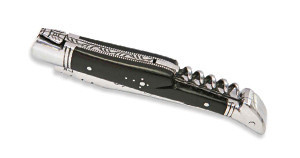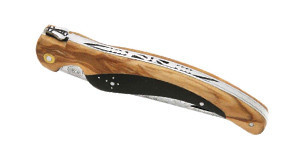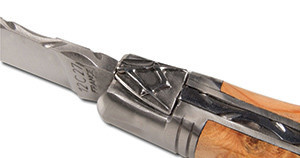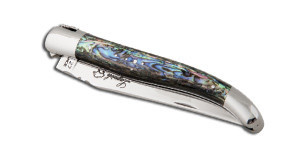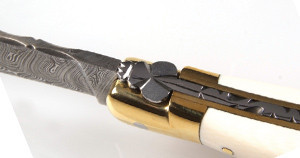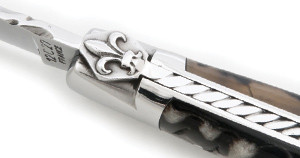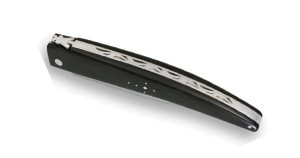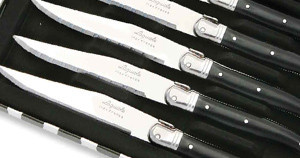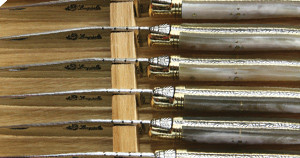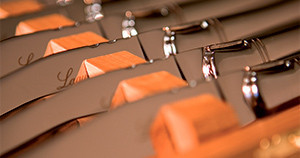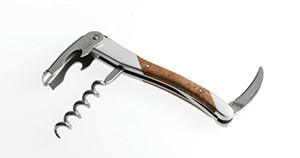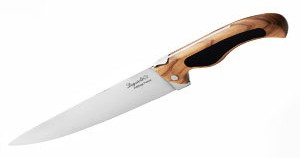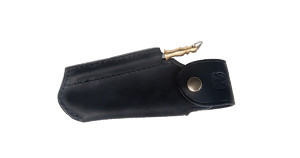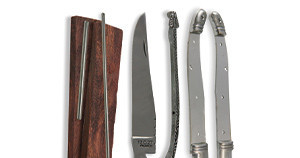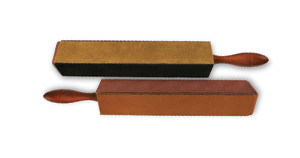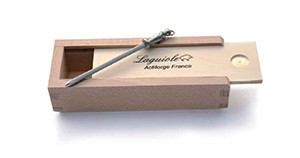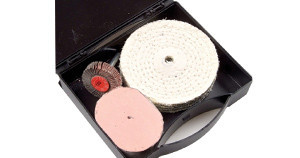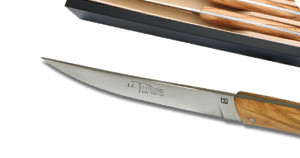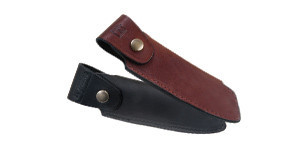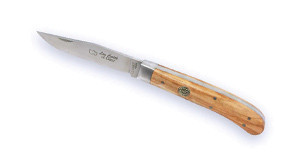Handles
Our knives are made in the town of Thiers, in the Auvergne region. The cutlery tradition of Le Thiers is a guarantee of high-quality steel. Altough the knife manufacturing process has evolved with time, Laguiole knives remain handcrafted knives handcrafted knives. Our knives are adjusted by hand according to ancestral methods. They have a lifetime warranty
.jpg) It took you awhile to choose the material for the handle of your favourite knife, particularly since there were so many great options to choose from. Now that you have in hand a faithful and robust companion, here’s what you need to know to give the attention it deserves.
It took you awhile to choose the material for the handle of your favourite knife, particularly since there were so many great options to choose from. Now that you have in hand a faithful and robust companion, here’s what you need to know to give the attention it deserves.
Each handle requires specific care if you wish to preserve the beauty and solidity of your Laguiole knife.
To avoid any faux-pas when it comes to cleaning your Laguiole, follow the advice of Thier’s masters in cutlery-making.
Whether your preference goes to wooden handles, precious materials or animal horn, you will find here simple and efficient care tips !
Looking after the handle of a Laguiole knife – it’s simple ! ‘This tip cannot be overstated : say goodbye to dishwashers !’
They are particularly harmful to your wooden or horn handles. You may make an exception if you chose Laguiole table knives with paperstone or perspex handles, since they can handle high temperature without incurring any damage.
.jpg)
How to look after the wooden handle of your Laguiole knife ? ?
Here’s a chart which allows you to quickly check how to care for precious wood handles !
Wood
Evolution over the years
Care
Snakewood
(Surinam)Darkens naturally, pattern tends to fade away - interesting patina
Clean with spirit of turpentine (or Coleman fuel) + use neutral wax
Rosewood
(Brazil)Tends to lighten when in contact with water
Clean with spirit of turpentine (or Coleman fuel) + ue palm oil wax or neutral wax
Kingwood
(Brazil)Darkens naturally
Clean with spirit of turpentine (or Coleman fuel) + ue palm oil wax or neutral wax
Birch
(Northern Europe)Darkens slowly, beware of stains
Clean with spirit of turpentine (or Coleman fuel) + linseed oil
Boxwood
(France)Beware of stains
Clean with spirit of turpentine (or Coleman fuel) + duck or goose fat
Ebony
(Africa)White-ish fiber slowly shows trough
Clean with spirit of turpentine (or Coleman fuel)
Juniper
(France and Europe)Slowly darkens
Requires regular care
Clean with spirit of turpentine (or Coleman fuel) + linseed oil
Olive-tree
(France Spain Italy)Goes dull without care
Clean with spirit of turpentine (or Coleman fuel) + linseed oil
Rosewood
(South America)Tends do lighten when in contact with water
Clean with spirit of turpentine (or Coleman fuel) + use palm oil wax or neutral wax
Thuja
(Maroc)Slowly darkens
Requires regular care
Clean with spirit of turpentine (or Coleman fuel) + linseed oil
If you regularly use your knife, the sweat from the palm of your hand is the best care product and produces the best-looking patina.
Knives with a wooden handle are equipped with woods chosen for their resistance and beauty, but they are all different. That is why it is very difficult to find two identical wooden handled knives.
You can fix cracks by using a similar-coloured wood powder (same type of wood or tint the wood). Mix this sawdust with colourless glue and pack it in the cracks. Let it dry and then wax your handle to make it shine once more.
Note : Wood is a living material which acquires patina and evolves with time. Therefore it is impossible to keep the wooden handle of a knife ‘as good as new’. It will change over time, just like you !
.jpg)
Caring for ivory, horn and antler handles.
- Mammoth tusk
This type of ivory comes from the tusks of mammoths who disappeared approximately 10,000 years ago. These tusks come from the Alaskan and Siberian permafrost (permanently frozen ground). Contrary to what many people think Mammoth ivory is a perfectly legal product !
Mammoth ivory is usually beige, off-white or brownish-coloured. In some cases, tusks are found in soil which contains various metal oxides which give unique tints to the external layer of the tusk.
- Bone (whale, moose, giraffe, ox, etc.)
A type of material used by humans since times immemorial. Creamy-white to beige in its natural form, can be dyed do give it a multitude of original colours. Once polished, bone looks like ivory.
- Antlers
From various members of the deer family (deer, moose, wapiti, etc.). Yet another material which has been used for ages to make weapons and tools. ‘Antlers grow and fall’ every year so no harm is done to the animals. Depending on the species, the colour changes (usually ranges from brown to off-white) and they may be either very textured or smooth.
Caring for and re-hydrating your handles made from animal material
Handles made from antlers or bone are beautiful things but, being natural materials, they contain a certain amount of water. They can therefore dry out over time if they aren’t properly cared for and shrink or even crack for deer antler handles, thus exposing the tang. This is particularly true in places with a year-round dry climate.
To avoid such trouble, here are a few tips to ‘re-hydrate’ your antler handles and keep them beautiful full so as to prevent cracking. Note that other materials such as bone or ivory can shrink over time and also require similar care.
You will need :
- A large container/ glass beaker (at least high enough to accommodate the knife handle)
- Mineral oil
- Methylated spirits
- RagsMicro-cristalline wax polish (optional)
Follow these steps to rehydrate a bone / antler / ivory handle :
Prepare the knife handle. Wipe it with methylated spirits to remove any dirt, oil and surface humidity.
Pour mineral oil in the beaker. Fill the beaker so that once the handle is placed inside , the oil level is slightly above the tang (i.e, all of the handle is immersed).
Place the knife in oil, do this handle first so that the blade sticks out of the container.
Leave it to soak for 24 hours. This gives the oil time to seep into the pores of the bone and properly hydrate it.
Inspect the handle. It should be slightly bigger and the cracks and gaps should be less visible.
Soak it again if necessary. If the antler handle has never been soaked previously (even before shrinking), soak it in oil for a couple more days.
Wipe it and store it. Alternately, once it is oil-free, apply Micro-cristalline wax polish to retain moisture.
This should improve the condition of your bone handle. It should be done every 3 months or so, or even more accurately, as soon as the handle begins to shrink.
BE CAREFUL THOUGH : Mineral oil can darken natural bone and ivory. Use it with caution and always do a test on a small area first.
• Black-horn-tip handle :
It is made from the full tip of the horn, which is massive and dense. Horn handles are cut from solid horn, a token of quality and solidity. Horn used to be favoured over bone for this solidity.
Black horn was said to be more robust, probably due to its origin (buffalo horn). Very dark, it ranges from dark beige to uniform black.
Horn tip is much tougher than compressed horn (hollow base of the horn, used in plates, to make combs and certain cutlery plates...)
Care tips for horn handles.
Horn is a natural material, over time your handle may dry out and start showing surface fiber. To avoid this, remember to oil your handle from time to time to nourish it, just like wood. To restore it, after time has wrought some damage, use a very fine grain sandpaper (400-grit), lightly sand it and polish it (with linseed oil, for example).
To keep your handle in good condition for as long as possible : Do not leave it in water, do not expose it to high temperatures (>50°C). Use a wet cloth to clean your knife, rather than rinsing it in water. Obviously, dishwashers are proscribed !
To maintain handles in good condition, try to avoid sharp variations in temperatures and humidity levels.
Horn-handled knives are made of natural living materials. Therefore Horn plates cannot be the same from one knife to another.
For example, the number of white stripes can vary from one black-horn knife to another. They can be cleaned by rubbing in some whiting (calcium carbonate). Neatsfoot oil or mineral oil are the best and can also be used. The idea is to maintain balanced moisture levels in the horn. If it gets too dry, it cracks. The oil will hydrate it.
.jpg)
Caring fot the handle of an atypical Laguiole..
• Mother-of-pearl.
Mother-of-pearl can be found inside the shells of oysters and other mollusks. This material is characterized by its luster and shine. It is made of layers of mineral aragonite which protect the mollusk from algae.
It must be protected from shocks and kept in a case to avoid being scratched. Wiping it with a soft wet cloth is all that’s needed to make it beautiful again.
• Paperstone.
Paperstone is the only solid material made entirely out of recycled FSC-standard paper. This material is environmentally-friendly, food-safe and water-resistant.
Did you know ? : PaperStone is one of the rare solid-surface materials certified FSC-level by the Smartwood Programme of the Rainforest Alliance.
Super-resistant, this material can go in the dishwasher, follow you in your wet underbrush adventures and accompany you in your savanna treks!
CLEANING THE MOBILE AND METALLIC PARTS OF YOUR KNIFE.
☑ Knives do not appreciate pocket dust.
☑ From time to time, impurities should be cleaned removed from the articulation systems with petroleum spirit and a concentrated air spray.
☑ Then add a drop of oil in the locking system.
All the other metallic parts of the knife – steel, nickel silver, brass- can simply be polished with a polishing compound and a cotton cloth.
Do not hesitate to ask your questions directly by email if you would like to know how to care for a knife made of a material which is not covered by this article.



